Relationships built between students and teachers have an important part in developing a suitable learning environment in the field of education.
These relationships have a far-reaching impact on kids’ academic progress, emotional well-being, and general development.
Understanding the significance of strong student and teacher relationships, educators are increasingly seeking effective strategies to build meaningful connections that go beyond the traditional roles of instructor and learner.
The purpose of this comprehensive handbook is to investigate the various aspects of improving student-teacher interactions.
By providing practical insights, actionable advice, and evidence-based techniques, this post aims to equip educators with the tools necessary to cultivate positive and productive interactions with their students.
Furthermore, it offers valuable insights to students, empowering them to actively participate in building mutually beneficial relationships with their teachers.
Throughout this guide, I will explore various dimensions of student and teacher relationships, including the dynamics, challenges, and benefits associated with fostering strong connections.
I will delve into strategies for effective communication, empathy-building, conflict resolution, and the utilization of technology to enhance relationships in the digital age.
In addition, I will discuss how important it is for parents and guardians to promote and reinforce strong connections between kids and instructors.
By implementing the strategies and techniques outlined in this guide, educators and students alike can cultivate an environment where trust, respect, and collaboration thrive.
Finally, via the power of strong student and teacher connections, this handbook aims to inspire a dramatic shift in the educational environment, boosting student engagement, academic accomplishment, and overall well-being.
SEE ALSO: How to End a Debate
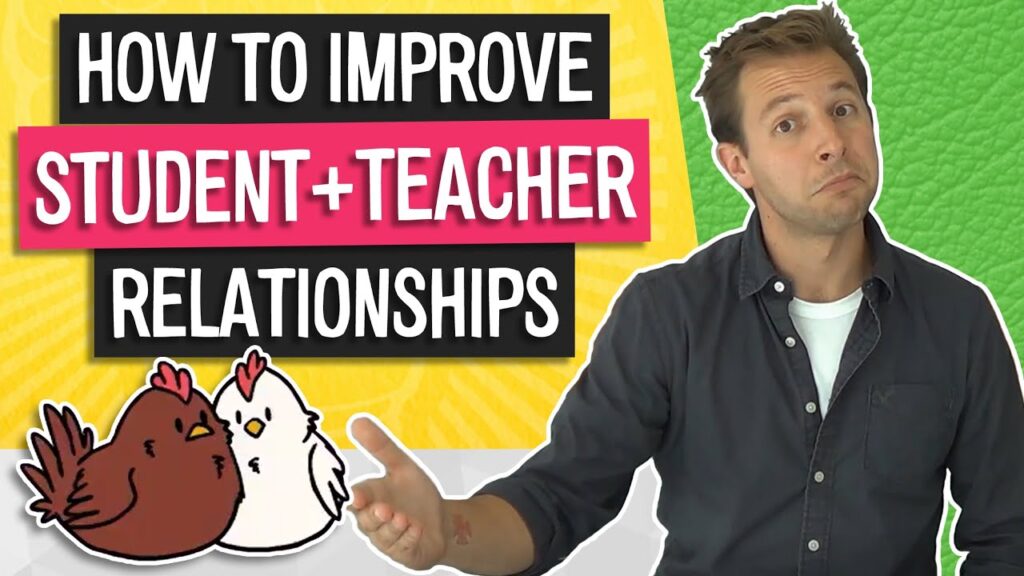
Understanding the Dynamics of Student and Teacher Relationships
A. The Meaning and Importance of Student-Teacher Relationships
Student and teacher relationships encompass the dynamic connections formed between educators and their students within the educational setting.
These relationships extend beyond the traditional roles of imparting knowledge and receiving instruction.
They involve establishing trust, fostering mutual respect, and nurturing a supportive environment that enhances learning and growth.
The significance of student and teacher relationships cannot be overstated.
Positive relationships have been found in studies to boost academic achievement, increase student engagement, and improve general well-being.
Students are more likely to actively participate in the learning process, take risks, and persevere when they feel appreciated, understood, and supported by their professors.
B. Impact of Positive Relationships on Student Engagement
Positive student and teacher relationships have a profound impact on student engagement.
Students gain a sense of belonging and responsibility over their education when they feel linked to their teachers.
This connection promotes active involvement in classroom activities, encourages collaboration with peers, and fosters a desire to achieve academic goals.
Moreover, strong relationships with teachers can positively influence students’ attitudes towards learning.
Students become more motivated, curious, and excited about their studies when teachers create a helpful and nurturing environment.
They are more likely to embrace new challenges, explore their interests, and develop a lifelong love for learning.
C. Common Challenges in Building Strong Relationships
Building strong student and teacher relationships is not without its challenges.
Educators face various obstacles in fostering connections with their students, including:
- Diverse Student Backgrounds: Students have a wide range of cultural, social, and emotional origins. Understanding and accommodating these differences requires educators to be sensitive, adaptable, and culturally competent.
- Communication Barriers: Effective communication forms the foundation of strong relationships. However, communication between teachers and students can be hampered by language hurdles, learning challenges, or other causes. Overcoming these barriers requires patience, active listening, and the use of appropriate communication strategies.
- Limited Time and Resources: Teachers often face time constraints and limited resources, making it challenging to dedicate individual attention to each student. Balancing the demands of curriculum requirements and personalized interactions necessitates effective time management and creative solutions.
- Conflicting Expectations: Students and teachers may have differing expectations and perceptions, which can create tensions within the relationship. Open dialogue, setting clear expectations, and fostering a shared understanding can help navigate and resolve these conflicts.
By acknowledging and addressing these challenges, educators can proactively work towards building strong relationships with their students.
Educators can set the groundwork for genuine connections that have a tremendous impact on students’ educational journeys by committing to understanding, empathy, and effective communication.
SEE ALSO: Expressing Gratitude: Heartfelt Words of Appreciation for Teachers from Parents and Students
Creating a Positive Classroom Environment
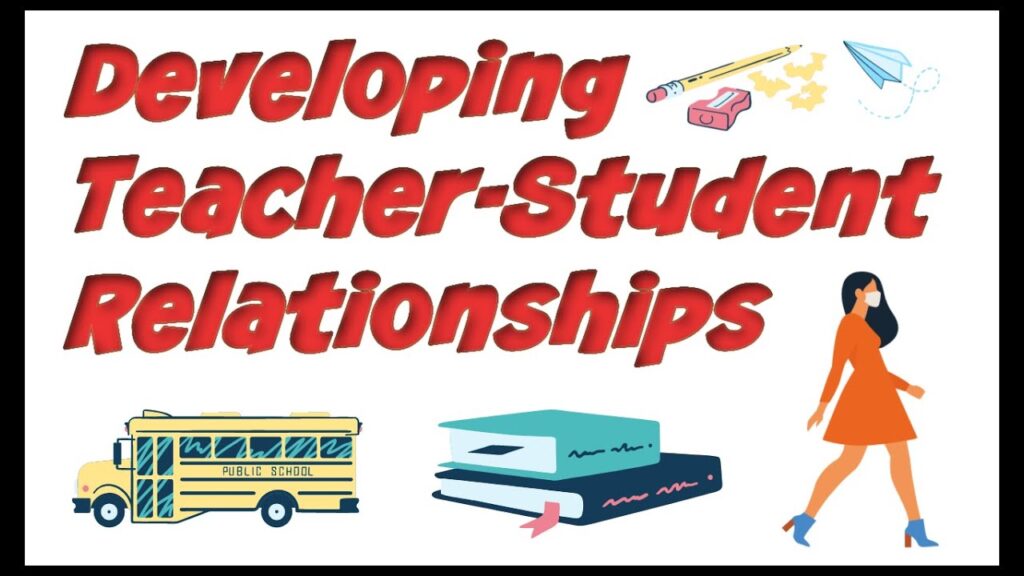
A. Establishing a Supportive and Inclusive Atmosphere
Creating a positive classroom environment is essential for cultivating strong student and teacher relationships.
To establish a supportive and inclusive atmosphere:
- Promote Respect: Set clear expectations for respectful behavior and model it consistently. Encourage kids to respect and value their peers’ viewpoints and experiences.
- Embrace Diversity: Celebrate the diversity within the classroom by incorporating multicultural perspectives and experiences into the curriculum. Create a safe space where students feel comfortable expressing their identities.
- Foster Collaboration: Encourage collaboration and teamwork among students. Provide opportunities for group projects, discussions, and cooperative learning activities that promote interaction and cooperation.
B. Fostering Trust and Respect
Building trust and respect is crucial for developing positive relationships.
Consider the following strategies:
- Be Approachable: Create an open-door policy where students feel comfortable approaching you with their questions, concerns, or ideas. Listen actively, show empathy, and provide constructive feedback.
- Demonstrate Consistency: Establish consistent expectations, rules, and consequences within the classroom. Consistency helps students feel secure and builds trust in your fairness and reliability.
- Value Student Input: Involve students in decision-making processes related to classroom rules, activities, and projects. Empower them to have a voice and actively engage in shaping their learning environment.
C. Encouraging Open Communication
Effective communication is the cornerstone of strong relationships.
Here are ways to foster open communication:
- Active Listening: Practice active listening by giving students your undivided attention. Show genuine interest in their thoughts, concerns, and ideas. Repeat and clarify their statements to ensure understanding.
- Clear Communication Channels: Establish multiple channels of communication, such as class discussions, one-on-one conferences, and digital platforms. Adapt your communication style to meet the diverse needs of your students.
- Regular Feedback: Provide constructive and timely feedback to students on their progress, achievements, and areas for improvement. Acknowledge their efforts and offer guidance for growth.
Creating a positive classroom environment sets the stage for meaningful student and teacher relationships.
By fostering a supportive and inclusive atmosphere, promoting trust and respect, and encouraging open communication, educators can lay the groundwork for a collaborative and engaging learning environment that nurtures strong connections.
Effective Communication Strategies
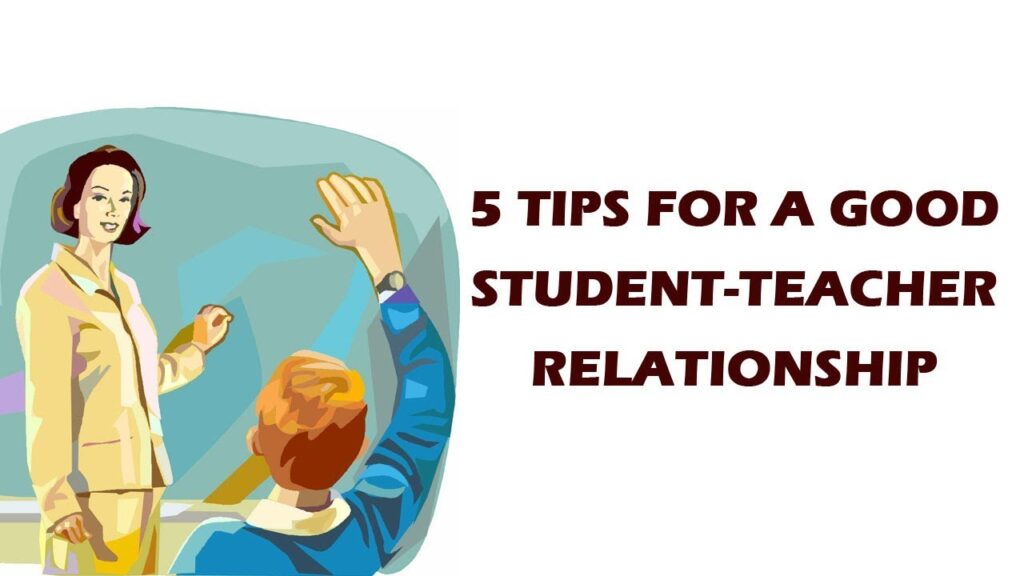
A. Active Listening Techniques
Effective communication involves active listening, which enhances understanding and strengthens relationships.
Employ the following techniques:
- Pay Attention: Give your full attention to the speaker, maintaining eye contact and avoiding distractions. Show genuine interest in what they have to say.
- Practice Empathetic Listening: Put yourself in the shoes of the speaker and try to grasp their point of view. Show empathy by acknowledging their emotions and validating their experiences.
- Ask Clarifying Questions: Seek clarification to ensure you fully understand the speaker’s message. Paraphrase or summarize their statements to demonstrate comprehension.
B. Nonverbal Communication Cues
Nonverbal cues play a crucial role in communication. Consider the following strategies:
- Body Language: Use open and welcoming body language to signal approachability. Maintain an upright posture, face the speaker, and use appropriate gestures to express interest and engagement.
- Facial Expressions: Display genuine facial expressions that reflect the emotions conveyed by the speaker. Smile, nod, and maintain an attentive expression to show active involvement.
- Tone and Voice Modulation: Use a warm and friendly tone of voice to convey empathy and understanding. Adjust your voice modulation to emphasize important points or convey enthusiasm.
C. Constructive Feedback and Encouragement
Providing constructive feedback and encouragement fosters a positive and growth-oriented environment.
Implement these strategies:
- Be Specific and Objective: Offer feedback that is specific, focused, and based on observable behaviors or actions. Avoid generalizations and provide examples to support your points.
- Balance Positive and Constructive Feedback: Recognize and acknowledge students’ strengths and achievements while providing constructive suggestions for improvement. Strike a balance between praise and areas for growth.
- Encourage Effort and Progress: Emphasize the importance of effort and progress over mere outcomes. Encourage kids to set reasonable goals, recognize their successes, and be supportive of their learning journey.
By implementing these effective communication strategies, educators can establish clear channels of understanding, empathy, and support.
Active listening, nonverbal cues, and constructive feedback create an environment where students feel heard, valued, and empowered to engage in meaningful dialogue with their teachers.
Developing Mutual Understanding and Empathy
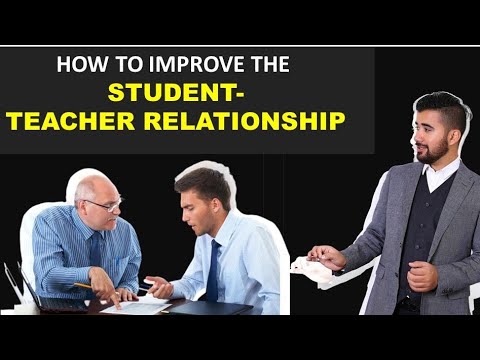
A. Recognizing Individual Differences and Unique Needs
Developing mutual understanding begins with recognizing and respecting the individual differences and unique needs of students.
Consider the following strategies:
- Embrace Diversity: Make an environment that values and promotes diversity in all of its forms, including cultural, linguistic, and learning diversity. Foster a classroom culture that appreciates and learns from the richness of different perspectives.
- Individualized Approach: Get to know your students as individuals. Discover their origins, hobbies, strengths, and weaknesses. Use this knowledge to tailor your teaching methods and support their unique learning needs.
- Differentiated Instruction: Implement differentiated instruction techniques to address diverse learning styles and abilities. Provide a variety of learning opportunities and adapt your teaching strategies to cater to individual student needs.
B. Cultivating Empathy in Teachers and Students
Empathy is a key component of building strong relationships.
Foster empathy within yourself and your students with the following approaches:
- Model Empathy: Demonstrate empathy in your interactions with students. Show understanding, compassion, and consideration for their perspectives and experiences.
- Encourage Perspective-Taking: Promote perspective-taking activities that encourage students to see situations from different viewpoints. Engage in discussions and role-playing exercises that help them develop empathy for others.
- Cultivate a Caring Classroom Community: Foster a sense of community in the classroom by promoting kindness, cooperation, and mutual respect. Encourage your syudent to help and sympathize with one another.
C. Promoting Cultural Awareness and Sensitivity
Cultural awareness and sensitivity contribute to mutual understanding.
Incorporate these strategies:
- Intercultural Learning: Integrate multicultural content into your curriculum to expose students to diverse cultures, traditions, and perspectives. Encourage discussions that promote cultural understanding and appreciation.
- Respectful Dialogue: Create opportunities for open and respectful dialogue about cultural differences and similarities. Encourage pupils to share their knowledge and experiences with one another.
- Address Stereotypes and Biases: Address stereotypes and biases directly by engaging students in critical discussions. Help them challenge assumptions and foster a more inclusive and accepting environment.
By focusing on developing mutual understanding and empathy, educators can establish a classroom environment where all students feel valued and understood.
Recognizing individual differences, cultivating empathy, and promoting cultural awareness and sensitivity create a foundation for meaningful connections between students and teachers.
Building Rapport and Connection
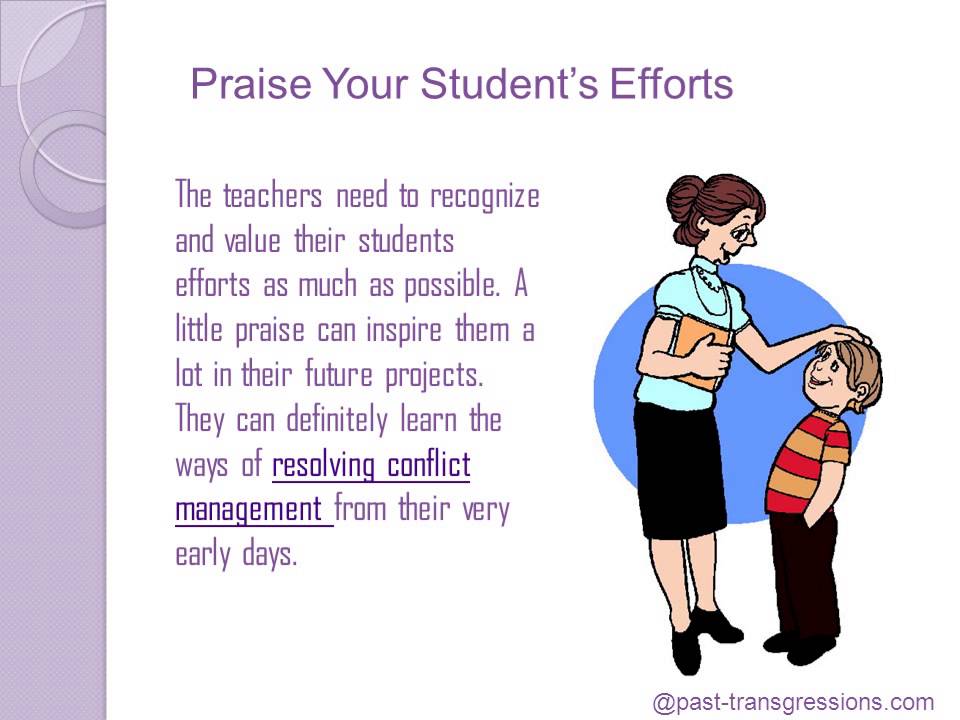
A. Getting to Know Students on Personal and Academic Levels
Building rapport and connection with students involves getting to know them both personally and academically.
Consider the following strategies:
- Establish a Welcoming Environment: Create a warm and inviting classroom atmosphere where students feel comfortable expressing themselves. Greet them individually, show interest in their lives, and create opportunities for informal conversations.
- Student Surveys or Questionnaires: Gather information about students’ interests, hobbies, and learning preferences via surveys or questionnaires. This information can help you tailor your instruction and connect with students based on their individual interests.
- Personalized Check-Ins: Check in with students on a frequent basis to enquire about their well-being, academic achievement, and any issues they may have. Show genuine care and offer support when needed.
B. Encouraging Student Participation and Collaboration
Active student participation and collaboration contribute to building rapport and connection.
Employ these strategies:
- Engage in Collaborative Activities: Incorporate group work, projects, and discussions that require students to collaborate and communicate with one another. Encourage teamwork, active participation, and sharing of ideas.
- Value Student Input: Provide opportunities for students to contribute their thoughts, opinions, and perspectives during class discussions. Acknowledge and validate their contributions, fostering a sense of ownership in the learning process.
- Recognize and Celebrate Achievements: Acknowledge and celebrate students’ academic, personal, and social achievements. This recognition reinforces their value and strengthens the teacher-student bond.
C. Incorporating Student Interests and Experiences
Incorporating student interests and experiences into the learning process deepens connections.
Consider these approaches:
- Relevant and Relatable Content: Integrate topics and examples into your lessons that align with students’ interests, backgrounds, and real-life experiences. This connection increases engagement and relevance.
- Student Choice and Autonomy: Provide opportunities for students to make choices in their learning, such as selecting research topics or project formats. Empowering students with autonomy increases their investment in their education.
- Share Personal Experiences: Share appropriate personal anecdotes or stories that connect to the content being taught.
- This humanizes the learning experience and helps students relate to you as a person.
By actively building rapport and connection with students, educators create an environment that fosters trust, engagement, and positive relationships.
Getting to know students on personal and academic levels, encouraging participation and collaboration, and incorporating their interests and experiences into the learning process contribute to a meaningful teacher-student connection.
Strategies for Addressing Conflict and Challenges
A. Resolving Conflicts in a Constructive Manner
Conflict is a natural part of human interaction.
Employ these strategies to address conflicts in a constructive manner:
- Encourage Open Dialogue: Create a safe space for students to express their concerns and perspectives. Encourage active listening, respect for differing viewpoints, and constructive communication.
- Mediation and Negotiation: Intervene when conflicts arise and guide students through a mediation or negotiation process. Help them identify common ground, find mutually agreeable solutions, and reach compromises.
- Teach Conflict Resolution Skills: Explicitly teach students effective conflict resolution skills, such as active listening, problem-solving, and empathy. Provide opportunities for role-playing or scenario-based activities to practice these skills.
B. Handling Difficult Student Behaviors
Challenging behaviors can strain student-teacher relationships.
Employ these strategies to address difficult behaviors:
- Establish Clear Expectations: Set clear behavioral expectations from the beginning and communicate them consistently. Create a positive behavior management system that reinforces positive conduct and addresses negative behaviors.
- Positive Reinforcement: Recognize and reinforce positive behaviors through verbal praise, rewards, or privileges. This encourages students to repeat desirable behaviors and reduces the occurrence of challenging behaviors.
- Individual Support Plans: Develop individualized behavior support plans for students who require additional assistance. Collaborate with other professionals, involve parents, and provide targeted interventions to address specific behavioral needs.
C. Supporting Students Facing Personal Challenges
Students facing personal challenges may require additional support.
Consider these strategies:
- Cultivate a Supportive Environment: Create a caring and supportive classroom atmosphere where students feel safe sharing their personal challenges. Show empathy, respect confidentiality, and provide a nurturing space for them to seek assistance.
- Establish Connections with Support Services: Collaborate with school counselors, social workers, and other support staff to address students’ personal challenges. Make referrals when necessary and maintain open lines of communication to ensure comprehensive support.
- Differentiated Instruction and Flexible Expectations: Modify instructional strategies and accommodate individual student needs when personal challenges arise. Offer flexibility in deadlines, provide additional resources, and offer extensions when appropriate.
By implementing these strategies, educators can effectively address conflicts and challenges that arise in the classroom.
Resolving conflicts in a constructive manner, handling difficult behaviors with positive approaches, and providing support to students facing personal challenges contribute to maintaining a positive and productive student-teacher relationship.
Utilizing Technology to Enhance Relationships
A. Leveraging Digital Tools for Communication and Collaboration
Technology offers numerous opportunities to enhance student-teacher relationships.
Consider these strategies:
- Online Communication Platforms: Utilize digital platforms, such as email, messaging apps, or learning management systems, to maintain regular communication with students. Respond promptly to inquiries, provide updates, and offer support.
- Virtual Office Hours: Schedule virtual office hours using video conferencing tools to provide one-on-one support and guidance to students. This allows for personalized interaction and fosters a sense of accessibility and support.
- Digital Feedback and Assessment: Provide timely and specific feedback to students using digital tools. Utilize features such as comment annotations, audio recordings, or rubric-based evaluations to offer constructive feedback that helps students understand their progress.
B. Promoting Online Engagement and Participation
Technology can facilitate active engagement and participation in the digital realm.
Employ these strategies:
- Discussion Forums and Online Platforms: Establish online discussion forums or platforms where students can engage in asynchronous discussions, share ideas, and collaborate on projects. Encourage active participation and provide guidance to foster meaningful interactions.
- Interactive Polling and Quizzing: Use polling or quizzing tools to gauge student understanding, solicit opinions, or gather feedback. These interactive activities promote active participation and provide valuable insights into students’ learning progress.
- Virtual Collaboration Tools: Employ digital collaboration tools, such as shared documents, virtual whiteboards, or project management platforms, to facilitate teamwork and cooperative learning. Encourage students to collaborate virtually on assignments and projects.
C. Overcoming Potential Challenges and Pitfalls
While utilizing technology can enhance relationships, it is essential to be mindful of potential challenges and pitfalls:
- Digital Equity: Address disparities in access to technology by providing alternative options for students who may not have reliable internet or access to devices. Explore solutions like loaned devices or offline resources to ensure equal participation.
- Privacy and Safety: Prioritize students’ privacy and safety when utilizing technology. Familiarize yourself with data protection guidelines, obtain necessary permissions, and use secure platforms for communication and collaboration.
- Balancing Technology Use: Maintain a balance between online and offline interactions. Foster opportunities for face-to-face engagement and ensure that technology serves as a tool to enhance relationships rather than replace personal connections.
By harnessing the power of technology, educators can enhance student-teacher relationships by leveraging digital tools for communication, promoting online engagement and participation, and navigating potential challenges.
Strategic use of technology can facilitate meaningful interactions, foster collaboration, and create a dynamic learning environment that supports strong connections between students and teachers.
Involving Parents and Guardians in the Process
A. Importance of Parent-Teacher Partnerships
Collaborating with parents and guardians is essential for fostering strong student-teacher relationships.
Recognize the significance of parent-teacher partnerships with the following considerations:
- Shared Responsibility: Acknowledge that parents and guardians are valuable partners in their child’s education. Working together, you can provide consistent support and create a unified approach to enhance student success.
- Home-School Connection: Understand that the home environment plays a crucial role in a student’s academic journey. By involving parents and guardians, you can bridge the gap between home and school, ensuring a holistic approach to education.
- Parental Involvement Benefits: Research consistently demonstrates the positive impact of parental involvement on student achievement, motivation, and overall well-being. Engaging parents and guardians can lead to improved academic outcomes and a stronger sense of community.
B. Effective Communication Strategies with Parents
Establishing effective communication with parents and guardians is vital for building strong relationships.
Consider these strategies:
- Open Channels of Communication: Provide various channels for communication, such as email, newsletters, parent-teacher conferences, or online platforms. Regularly update parents on their child’s progress, upcoming events, and important information.
- Two-Way Communication: Encourage parents to share their insights, concerns, and questions. Actively listen, respond promptly, and value their input. Engage in constructive dialogue that fosters mutual understanding and partnership.
- Positive News and Celebrations: Share positive news about students’ accomplishments, growth, or contributions with parents. Recognize their support and involvement in their child’s education, reinforcing the collaborative relationship.
C. Collaborating to Support Student Success
Collaboration between teachers and parents can significantly impact student success.
Implement these strategies:
- Parent Involvement Opportunities: Provide opportunities for parents to actively engage in their child’s education, such as volunteering in the classroom, participating in school events, or joining parent committees. Their involvement fosters a sense of ownership and strengthens relationships.
- Parent Education and Workshops: Offer workshops or informational sessions to provide parents with insights into educational strategies, resources, or ways to support their child’s learning at home. Empower parents with tools and knowledge to enhance their involvement.
- Individualized Support: Collaborate with parents to create individualized support plans for students who may require additional assistance. Share strategies, resources, and progress updates to ensure a consistent approach between home and school.
By involving parents and guardians in the educational process, educators can cultivate a strong support system that enhances student-teacher relationships and ultimately contributes to student success.
Emphasize the importance of parent-teacher partnerships, establish effective communication strategies, and collaborate to support students holistically.
SEE ALSO: Teacher Appreciation Ideas for Staff
Assessing and Monitoring Relationship Progress
A. Developing Assessment Methods for Relationship Building
Assessing and monitoring the progress of student-teacher relationships allows for continuous improvement and adjustment.
Consider these methods for evaluating relationship building:
- Surveys and Questionnaires: Design surveys or questionnaires to gather feedback from students and parents about their perceptions of the student-teacher relationship. Include questions about trust, communication, and overall satisfaction.
- Reflective Journals or Self-Assessments: Encourage students to maintain reflective journals or self-assessments where they can express their thoughts and feelings about their relationship with their teachers. This allows for self-reflection and can provide valuable insights.
- Peer Observations and Feedback: Implement a peer observation system where teachers observe and provide feedback to one another. This can offer an external perspective on relationship-building practices and identify areas for improvement.
B. Tracking and Monitoring Student Engagement and Satisfaction
Monitoring student engagement and satisfaction provides valuable indicators of the quality of student-teacher relationships.
Consider the following approaches:
- Classroom Observations: Conduct regular classroom observations to assess student engagement levels, participation, and interactions. Observe the dynamics of student-teacher relationships and note any patterns or areas of improvement.
- Academic Progress and Performance: Monitor students’ academic progress, grades, and performance. Consider if there are correlations between their achievement and the strength of their relationship with their teachers.
- Student and Parent Feedback: Actively seek feedback from students and parents about their satisfaction with the student-teacher relationship. Consider their perspectives on communication, support, and overall engagement in the learning process.
C. Adjusting Strategies Based on Evaluation Results
Evaluating relationship progress is not enough; it is essential to use the findings to inform adjustments and improvements.
Consider these strategies for adapting relationship-building strategies:
- Reflection and Self-Assessment: Reflect on evaluation results and consider areas where improvements can be made. Engage in self-assessment to identify personal strengths and areas for growth in building student-teacher relationships.
- Professional Development: Seek professional development opportunities focused on relationship building. Attend workshops, conferences, or webinars that offer strategies and insights into fostering positive connections with students.
- Continuous Communication and Feedback Loops: Maintain open lines of communication with students, parents, and colleagues. Regularly seek feedback and engage in dialogue to address concerns, make necessary adjustments, and refine relationship-building strategies.
By implementing assessment methods, tracking engagement and satisfaction, and adjusting strategies based on evaluation results, educators can continuously improve their approaches to building strong student-teacher relationships.
The process of assessment and monitoring enables educators to adapt their practices to better meet the needs of students and foster positive and productive connections.
See How Food Can Be a Meaningful Gesture
Summary
Building strong student and teacher relationships is a vital aspect of creating a positive and effective learning environment.
Here are the key takeaways and best practices for improving these relationships:
- Recognize the Significance: Understand the importance of student and teacher relationships in fostering academic success, engagement, and overall well-being.
- Establish a Supportive Environment: Create a classroom atmosphere that is inclusive, respectful, and supportive. Embrace diversity, encourage collaboration, and foster open communication.
- Practice Effective Communication: Employ active listening techniques, utilize nonverbal communication cues, and provide constructive feedback. Clear and empathetic communication strengthens relationships.
- Develop Understanding and Empathy: Recognize and respect individual differences, cultivate empathy, and promote cultural awareness and sensitivity.
- Build Rapport and Connection: Get to know students personally and academically, encourage their participation and collaboration, and incorporate their interests and experiences into the learning process.
- Address Conflict Constructively: Resolve conflicts through open dialogue, mediation, and negotiation. Teach conflict resolution skills to students and create a positive conflict resolution culture.
- Handle Difficult Behaviors with Positive Approaches: Set clear expectations, reinforce positive behaviors, and develop individual support plans when needed. Focus on building on strengths and providing guidance.
- Utilize Technology Thoughtfully: Leverage digital tools for communication, collaboration, and engagement. Overcome challenges related to digital equity and privacy while maintaining a balance between online and offline interactions.
- Involve Parents and Guardians: Recognize the importance of parent-teacher partnerships, establish effective communication channels, and collaborate to support student success. Share information, seek feedback, and involve parents in their child’s education.
- Assess and Monitor Relationship Progress: Implement assessment methods, track engagement and satisfaction, and adjust strategies based on evaluation results. Continuously reflect, seek feedback, and adapt practices to strengthen relationships.
By implementing these key takeaways and best practices, educators can cultivate strong student and teacher relationships, creating a supportive and engaging learning environment that nurtures academic success and overall well-being.
SEE ALSO: Teacher Appreciation Importance
FAQs
Here are some commonly asked questions about improving student and teacher relationships:
A. How long does it take to build a strong student-teacher relationship?
Building a strong student-teacher relationship is a process that develops over time. The duration may vary depending on factors such as the individual student and teacher, the frequency of interactions, and the level of trust and rapport established. Consistent efforts, effective communication, and mutual understanding contribute to the gradual development of a strong relationship.
B. What if a teacher is facing difficulties in connecting with a student?
If a teacher is facing difficulties in connecting with a student, several strategies can be employed. First, try to understand the reasons behind the challenge by considering factors such as the student’s background, learning style, or personal circumstances. Adapt teaching approaches, seek opportunities to get to know the student better, and demonstrate empathy and patience. Collaboration with colleagues, seeking support from school resources, or involving parents can also be beneficial in addressing these challenges.
C. How can student-teacher relationships impact academic performance?
Strong student-teacher relationships have a positive impact on academic performance. When students feel connected, supported, and valued by their teachers, they are more likely to engage actively in the learning process. A supportive relationship can foster a positive attitude towards learning, increase motivation, and create a sense of belonging. Students who have a strong connection with their teachers often demonstrate improved academic achievement, higher levels of participation, and greater perseverance through challenges.
D. Can technology replace face-to-face interactions between students and teachers?
While technology can facilitate communication and engagement, it cannot fully replace face-to-face interactions between students and teachers. In-person interactions provide valuable nonverbal cues, opportunities for immediate feedback, and a sense of personal connection. However, technology can supplement and enhance relationships by providing additional avenues for communication, collaboration, and support, particularly in blended or online learning environments. It is important to strike a balance between technology use and face-to-face interactions to create a comprehensive learning experience.
E. How can parents contribute to fostering positive relationships with teachers?
Parents play a crucial role in fostering positive student-teacher relationships.
They can contribute by maintaining open lines of communication with teachers, attending parent-teacher conferences or meetings, and actively engaging in their child’s education.
Supporting learning at home, reinforcing classroom expectations, and valuing teachers’ efforts are also important.
Collaborating with teachers to address challenges, providing insights into their child’s needs and strengths, and offering support when necessary further strengthens the partnership between parents and teachers.
These FAQs address common inquiries related to improving student and teacher relationships.
However, each situation is unique, and it is important to approach relationship-building with flexibility, empathy, and a commitment to ongoing communication and collaboration.






